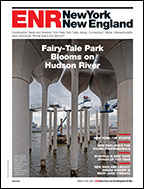As London’s main international airport at Heathrow nears full capacity, momentum is growing in the U.K. for a major new hub in the Thames Estuary. London Mayor Boris Johnson has been lobbying hard for an estuary airport for two years. Recently, architectural heavyweight Sir Norman Foster proposed a rival $80-billion estuary project that includes high-speed rail, tidal power and a major new utilities and data spine.
Foster’s Thames Hub would be built at the end of the Isle of Grain, Kent, some 55 kilometers east of central London. Over a third of the 40,000-hectare airport would be on land reclaimed, with about 280 million cu meters of material from the estuary. With four 4-km-long runways, the airport’s 150-million annual passenger capacity would be more than twice Heathrow’s, says Foster, chairman of Foster & Partners, London. Foster and two other firms developed the plan on their own.
Tidal generators on a roughly 1.8-km-long flood barrier would provide all the airport’s electricity or supply 250,000 homes, says Foster. The barrier also would carry road vehicles and a new high-speed railroad, serving 300,000 passengers a day, across the estuary into Essex. The 140-km-long railroad would bypass London, crossing its north side, and link to train services to Heathrow, some 25 km west of the city, and then the rest of the county. The aviation component accounts for 40% of the total cost.
“This is not just looking at an airport in isolation,” says Foster. “It’s part of a wider coordinated network which seeks to address a series of issues.”
The concept is not “fluffy” but stems from 22 technical studies, adds Ben Hamer, a director of London-based Halcrow Group, which is collaborating with Foster & Partners. The team, also including economists at Volterra Consulting, London, has involved some 60 staff over two years at cost to the firms in the “seven digits,” Hamer adds.
The construction is not difficult, says Hamer. “It’s been done in a number of places around the globe by British engineers and British architects and planners.” Able to be financed privately, “this can be delivered by the 2020s,” he claims.
Heathrow’s owner, BAA plc, acknowledges the hub plan as “a valuable contribution” to the aviation debate. But “Heathrow is the only airport in the U.K. that has the scale and capability as a global hub,” says a spokesman. “A new hub airport may take 25 years to build, and by then it will be too late,” he adds.
BAA had its plans for a third Heathrow runway rejected by the government. Under Foster’s plan, Heathrow would become “transitional,” ultimately shutting down.






